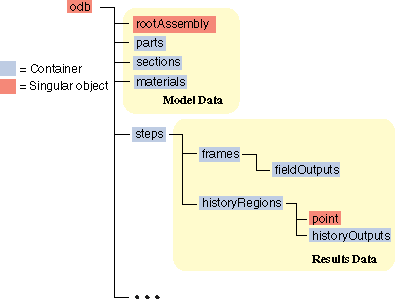How the object model for the output database relates to commands | ||
| ||
For example, consider the object model for field output data shown in Figure 1. The Odb object at the top of the figure is created when you issue the command to open or create an output database. As you move down the object model, an OdbStep object is a member of the Odb object; similarly, a Frame object is a member of the OdbStep object. The FieldOutput object has two members—fieldValue and fieldLocation.

The object model translates directly to the structure of an Abaqus Scripting Interface command. For example, the following command refers to a Frame object in the sequence of frames contained in an OdbStep object:
odb.steps['10 hz vibration'].frames[3]
Similarly, the following command refers to the sequence of field data contained in a FieldOutput object.
odb.steps['10 hz vibration'].frames[3].\
fieldOutputs['U'].values[47]
You use commands to access objects by stepping through the hierarchy of objects in the object model. The Access and Path descriptions in Odb commands describe the interface definition of the command. The interface definition of the command reflects the hierarchy of objects in the object model. If you are unsure of the structure of the output database, you can issue the objectname.__members__ command from the command line interface to view the members of an object.